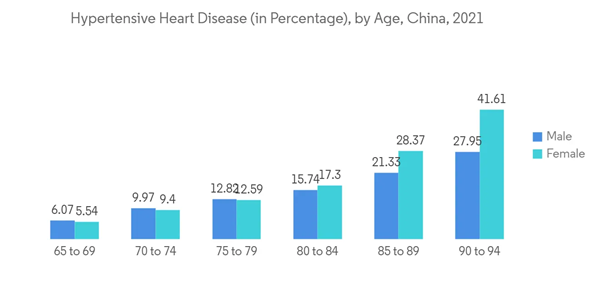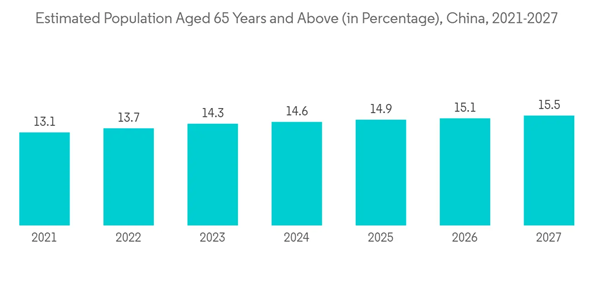The pandemic significantly impacted the patient monitoring market in China during the initial stages of the COVID-19 outbreak. As per the BMJ article published in February 2021, in China, remote health monitoring devices, mobile telecom devices, and cloud video services are used to collect and transmit information about patients in some isolation wards. The report also mentioned that wireless health monitoring equipment was used to monitor the patient's vital signs in the isolation wards in China. Thus, the usage of patient monitoring in managing COVID-19-infected patients in China during the pandemic had a crucial impact on the market growth. In addition, the demand for patient monitoring is expected to remain intact due to the rising focus on chronic diseases in patients during the post-pandemic period, fueling the market growth over the forecast period.
The increasing prevalence of chronic disease among the Chinese population, along with the rising demand for continuous monitoring, the increasing geriatric population is expected to contribute to the growth of the market. According to the NCBI article published in February 2022, asthma is a major public health challenge in China, with a national prevalence of asthma of 4.2%, representing 45.7 million Chinese adults. Such increasing prevalence of chronic disorders and various other injuries among the Chinese population is expected to drive the demand for patient monitoring owing to the effective management of these diseases, thereby fueling the market's growth.
However, the high cost of technology and stringent regulatory framework is expected to restrain the market's growth over the forecast period.
China Patient Monitoring Market Trends
Cardiology is Expected to Have Significant Share in the Market During the Forecast Period
Cardiac monitoring refers to continuous or intermittent monitoring of heart activity with an assessment of the patient's condition relative to their cardiac rhythm. Additional monitoring components allow cardiovascular pressures and cardiac output to be monitored and displayed as required for patient diagnosis and treatment. Continuous cardiovascular and pulmonary monitoring allows for prompt identification and initiation of treatment.The increasing prevalence of various heart diseases and rising demand for patient monitoring to manage cardiovascular disease efficiently are expected to contribute to the growth of the studied segment. For instance, the NCBI article published in January 2021 mentioned that in 2021, of the 290 million patients with cardiovascular disease patients in China, heart stroke affected nearly 13 million, coronary heart disease affected about 11 million, pulmonary heart disease affected approximately 4.5 million, affected over 2 million and others. Additionally, the data published by WPR in 2022 shows that one in every five adults in China had some cardiovascular disease in 2022. the report also mentioned a 50% increase in cardiovascular disease by 2030. Such increasing prevalence of cardiovascular diseases among the Chinese population is expected to drive the demand for patient monitoring, thereby contributing to the market's growth.
Neurology is Expected to Hold Notable Share in the Market Over the Forecast Period
The Neurology branch of healthcare deals with various neurological such as migraine, epilepsy, Alzheimer, Parkinson's diseases, acute spinal cord injury, ataxia, and others. The increasing prevalence of the above-mentioned neurological disorders among the Chinese population is expected to contribute to the increase in the demand for patient monitoring devices, thereby contributing to the growth of the studied segment.For instance, as per the article published by ST in November 2022, an estimated 10 million Alzheimer's patients are in china in 2022 and this number is expected to rise to 40 million by 40 million. Similarly, the Plos One article published in April 2021 mentioned that china had approximately 10 million people with epilepsy in 2021. Such prevalence of various neurological disorders among the Chinese population is expected to drive the demand for neurology monitoring among the patients, thereby contributing to the growth of the studied segment.
Also, the rising geriatric population who are most susceptible to developing neurological disorders in old age is expected to contribute to the growth of the studied segment. For instance, the data published by VC in May 2021, mentioned that the number of people aged 60 years and older was 17.9% of the Chinese population this share is expected to reach 34.6% by 2050.
Thus, the increasing prevalence of various neurological disorders, along with the rising geriatric population is expected to drive the demand for patient monitoring devices, thereby fueling the segment growth.
China Patient Monitoring Industry Overview
The patient monitoring market consists of several major players and is fragmented. Some of the major players in the market are Johnson & Johnson, Abbott Laboratories, Boston Scientific Corporation, GE Healthcare, and BD, among others.Additional Benefits:
- The market estimate (ME) sheet in Excel format
- 3 months of analyst support
This product will be delivered within 2 business days.
Table of Contents
Companies Mentioned (Partial List)
A selection of companies mentioned in this report includes, but is not limited to:
- Abbott Laboratories
- Baxter International Inc
- Becton, Dickinson and Company
- Boston Scientific Corporation
- Draegerwerk AG
- GE Healthcare
- Johnson & Johnson
- Koninklijke Philips NV
- Medtronic PLC
- Siemens Healthcare GmbH
Methodology

LOADING...










